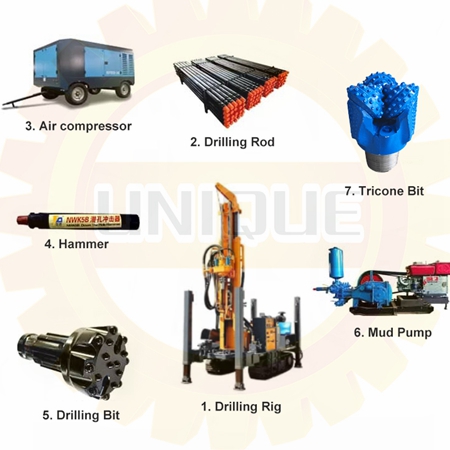How to choose a water well drilling rig: Professional analysis
1.Analysis of formation conditions
1.1 Matching formation type with drilling rig
1.1.1 Loose formation
– Loose formations such as sand and clay are prone to collapse and have rich aquifers. Mud pump water drills (rotary type) can use mud to protect the wall and prevent collapse. At the same time, the mud carries the rock cuttings out, and the drilling efficiency is high.
1.1.2 Hard rock formations
– Hard rock formations such as granite and limestone have high hardness and are difficult to drill. Air compressor drills (impact or composite) use high-pressure air to impact the drill bit, break the rock, and drill quickly, which is suitable for such formations.
1.1.3 Complex formations
– Complex formations are alternating between soft and hard, with broken zones and cracks. Composite drilling rigs (impact + rotary) have both impact and rotary functions, can flexibly switch drilling methods according to formation changes, and have strong adaptability.

2.Project requirements analysis
2.1 Project parameters and drilling rig selection
2.1.1 Well depth requirements
– Small drilling rigs can be used for shallow wells (<100 meters), medium-sized drilling rigs are required for medium-deep wells (100-300 meters), and high-power and stable drilling rigs are required for deep wells (>300 meters) to ensure drilling depth and equipment safety.
2.1.2 Well diameter requirements
– Small drilling rigs can be used for small-diameter (<200mm) wells, medium-sized drilling rigs are required for medium-diameter (200-500mm), and large-diameter (>500mm) drilling rigs with high torque are required to meet the construction requirements of different well diameters.
2.1.3 Water output target
– Small water volume (<10m³/h) wells do not require high drilling rigs, medium water volume (10-50m³/h) require high-efficiency drilling rigs, and high water volume (>50m³/h) require high-efficiency drilling equipment to increase water output.
2.2 Construction period and efficiency considerations
2.2.1 Projects with tight construction period
– When the construction period is tight, air compressor drills or high-efficiency rotary drills are the first choice. They have fast drilling speeds, can shorten the construction period, and complete the task on time.
2.2.2 Projects with general construction period
For projects with general construction period, drilling rigs can be selected comprehensively based on factors such as formation conditions and costs, balancing drilling efficiency and equipment costs to ensure the economic benefits of the project.
2.2.3 Long-term projects
-Long-term projects focus on equipment stability and durability. Although large, high-performance drilling rigs have large initial investments, they have low long-term use costs and are suitable for such projects.

3.Equipment performance comparison
3.1 Air compressor drill and mud pump drill
3.1.1 Drilling speed comparison
–Air compressor drill has fast drilling speed, suitable for hard rock formations, can quickly break rocks and improve construction efficiency; mud pump drill has slow drilling speed in loose formations, but has good mud wall protection effect and is suitable for complex formations.
3.1.2 Adaptability analysis
Air compressor drill is suitable for dry and hard rock formations, does not require water source, and is suitable for arid and water-scarce areas; mud pump drill is suitable for loose formations and aquifers, and the mud circulation system can effectively carry rock cuttings.
1.3 Environmental protection and maintenance cost
–Air compressor drill has large dust pollution and needs to be equipped with dust removal equipment; mud pump drill mud treatment requires environmental protection measures, both have high maintenance costs, but air compressor drill is relatively simple to operate.
4.Cost-benefit analysis
1 Comparison of cost items
4.1.1 Equipment purchase cost
The purchase cost of air compressor drill and mud pump water drill is relatively high. The air compressor and drill bit or mud pump and circulation system are the main costs, which need to be selected according to the budget and needs.
4.1.2 Operating cost
The air compressor drill consumes a lot of gas, and the electricity or fuel cost is high; the mud pump water drill consumes a lot of water and mud materials, and the local resource price and supply situation need to be considered.
4.1.3 Maintenance cost
The air compressor and drill bit need to be maintained regularly, and the dust removal equipment needs to be cleaned; the mud pump and drill bit also need to be maintained regularly. The maintenance cost of both is relatively high, and a reasonable maintenance plan needs to be arranged.
4.2 Comprehensive benefit considerations
4.2.1 Time benefit
The air compressor drill has a fast drilling speed, which is suitable for projects with tight time limits. It can quickly complete the drilling task and be put into use in advance to generate economic benefits.
4.2.2 Cost-effectiveness
Mud pump water drills are highly adaptable and suitable for complex formations. Although the purchase and operation costs are high, they can ensure the success rate of drilling and reduce the losses caused by drilling failures.
4.2.3 Long-term benefits
Although the initial investment of high-performance drilling rigs is large, the long-term use cost is low. They are suitable for long-term projects and can reduce the cost of equipment replacement and maintenance, thereby improving the overall benefits of the project.

5.Brand and after-sales service
5.1 Key points for brand selection
5.1.1 Brand awareness
Choose a well-known brand to ensure the quality and performance of the equipment. For example, drilling rigs produced by internationally renowned brands or large domestic enterprises have high market recognition.
5.1.2 User evaluation
Refer to other users’ evaluations and usage experience to understand the actual performance and reliability of the equipment and avoid choosing brands with poor reputation.
Collect information through industry forums, user feedback and other channels to understand the advantages and disadvantages of drilling rigs of different brands and provide a reference for selection.


